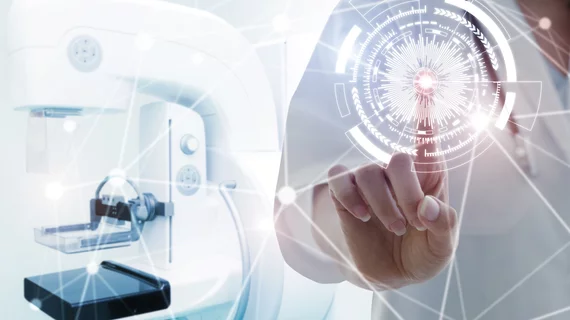An artificial intelligence-based mammography triage software is helping providers dramatically improve their interpretation process, according to a case study published Tuesday in the Journal of the American College of Radiology.
Patients can experience delays in receiving their breast imaging results for various reasons, such as physician shortages or failing to bring along previous outside exams. Such setbacks can lead to long delays along with patient uncertain and anxiety.
Wanting to address this challenge, an unnamed imaging center in Southern California and its partners implemented an AI software that aids in detection and triage of clinical concerns. Two years in, they’re seeing measurable gains in their work.
“Triage of screening mammograms resulted in significant improvement in reporting of recalled patients, thereby expediting workup,” lead author Marie Tartar, MD, a radiologist with Scripps Green Hospital in La Jolla, California, and colleagues wrote Oct. 5. “Subjectively, the radiologist experience over 2 years was improved by having fewer, more meaningful flags to evaluate and the perceived benefit of a sorted screening mammography work list,” they added later.
Tartar et al. first implemented the AI tool at a single outpatient site that utilizes 2D digital mammography in June 2019. AI evaluated all imaging exams immediately after completion, triaging any suspicious instances into a sortable worklist and sending a notification to physicians. The authors said integrating the tool into the organization’s picture archiving and communication system was “unproblematic.” However, radiologist buy-in was a challenge, with physicians facing fears of being replaced, distrust and resistance to learning this new approach.
Average turnaround times dropped from about 9.6 days based on 2019 data down to 3.9 this year following AI implementation. Among BI-RADS (Breast Imaging-Reporting and Data System) category 0 patients, that number dropped from 9.4 days (with a range of 1-33) down to 4.7 days (0-22). Exams with suspicious findings were typically interpreted within one day, leaving fewer held for outside comparisons. The team also recorded a 71% reduction in flags per examination when using artificial intelligence, going from 2.26 per exam down to 0.65. And this reduction was “comparable and significant” for both masses (down 72%) and calcifications (70%).
“Despite initial skepticism, a verbal survey of the interpreting radiologists performed two years after implementation showed universal preference for the AI-[computer-aided detection] compared with traditional CAD, the value of which has been questioned,” Tartar and colleagues wrote. “Furthermore, the use of triage is now seen as the preferred way to manage their work lists,” they added, highlighting the “perception of greater ease” when reading batched mammograms.

